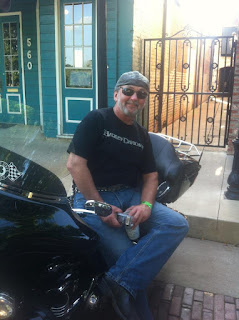Cont. from last month.
Central Track was also the place where Smith and his partner would find “Deep Ellum Shafts.” These were thin bladed knives that were carried by some of the locals and easily concealed. Sometimes the overworked Vice officers would have uniformed officers like Smith come along on raids of the joints along “The Track.”
As soon as police would enter the smoke filled bar, one could hear the unmistakable clinking of these knives hitting the floor. The motor officers would “jack ‘em up” looking for guns and any shafts that didn’t hit the floor. Sometimes the blues singers would admit to smoking grass, and as the stale air was full of it, somebody, well everybody was smoking dope. But this was part of the bluesman mantra. More often than not, the boys in blue would just have them eat it. Of course this did the trick as well, with the band playing very long and very fast after the police left.
Other times, without the Vice boys, Smith and the other motor jocks would stride in, boots gleaming, and pull out the brass knucks from a special place in his Sam Browne belt. Once, a newcomer said the wrong word and generally failed the “attitude test.” Smith smashed the guys face, turned around and walked out of the bar. These motor jocks were big, tough men, who rode big motorcycles. It took this kind of officer to survive in this area, and weakness shown would be an open invitation to failure. The police had to win every time, or it would be total chaos on “The Track.”
Cruising south away from the anarchy that was Central Track, Smith and his partner stopped at Label’s Pawn Shop. There were several swarthy looking guys standing nearby. Smith’s partner went in and asked Mr. Label if these guys were bothering the customers coming in. Label said no. Smith’s partner reported that these guys were musicians and were here for a concert at the Pythian Hall at Good (later Good Latimer) and Elm Streets.
After a late lunch at Issy Miller’s Café at Elm and Central Track, Smith decided it was time to take his new Harley on a test run. One of the best straight roads around was Samuell Blvd, which was on the way to Buckner Orphans Home and the country. His 1936 Harley-Davidson VL was much faster than his old 1929 model, smoother riding too. For fun he kicked the police siren, mounted on the right rear of the footboard with his boot. The siren engaged the rear tire and a great wail began. People and dogs scattered as he and his partner grinned at each other as they sped east on Samuell. He remembered that he must buy red lights for his new mount. It would be years before the department would furnish them.
Smith turned into Grove Hill Cemetery. His partner knew what the mission was. Smith went far back into the park leaving his partner at the cemetery gates. Here he found his old friend Motorcycle Officer Clarence Isbell. Marshall, his middle name which he went by was killed ten years previous on Forest Ave. Isbell and his partner was chasing a large touring car. As Isbell pulled up beside the car to order the driver to pull over, one of the occupants in the rear seat shot Isbell in the right temple. His partner chased the car but lost it. Isbell had ridden his bike a few yards apparently before he went down with his mount, probably dead before he hit the ground.
The suspect car was found the next day in the Trinity River bottoms. The vehicle was equipped with Acetylene tanks, mounted in the trunk. This was often used by hijackers, and stick-up men for fast getaways. The street where Isbell was killed was just a few blocks south of his home. Smith knew Marshall’s wife and kids who still lived at the house at 3003 Grand Ave. right down from Fair Park. He was comforted by the fact that the suspects were executed just two months after the murder of his friend. Smith wiped a tear from his cheek, made sure he was composed, and rode fast past his partner who still parked at a respectable distance at the gate.
Sometimes the two motor officers would stop and pay their respects to Motor Officer Ernest Leonard, killed just last year riding on old number 13. This police Harley was also known as the “Widow Maker” by the newspapers, never by the motor jocks however, who believed karma was ever present and one didn’t tempt fate by calling up evil monikers. Leonard was one of two Dallas officers killed between May and August 1935 on this most notorious of DPD Harley-Davidson’s. Police officials said that after the second wreck that the bike would be destroyed. Later it was found that indeed, it had not. Typical City of Dallas it was thought.
Not speaking, Smith and partner rode west towards the station. As he parked his bike, Smith noticed that this bike sounded different than his old one as it crackled and popped while cooling down. These machines speak to you he often thought. It was more of a sing song sound. Beautiful. “I’ll get to know this one too,” he said out loud. He started to call out to his partner to come and listen but he was out the door to the local police watering hole. Smith decided to leave it at that and hurried to catch up, as he was very thirsty.


















